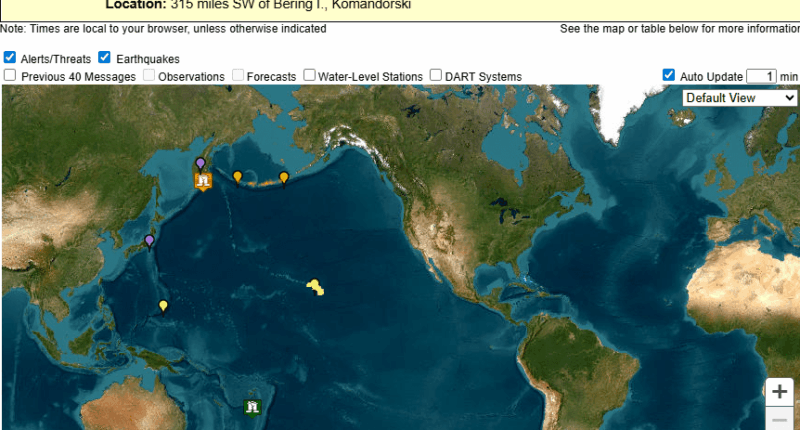Share this @internewscast.com
A HUGE earthquake has struck the coast of Russia – strong enough to cause tsunamis, with warnings issued for the Pacific Islands.
The magnitude 8.7 earthquake struck off Russia’s Kamchatka on Wednesday, the U.S. Geological Survey said.
It occurred about 84 miles off Kamchatska at around 7.24pm EST (12:30am BST).
The quake was shallow and strong enough to cause waves or a tsunami.
The U.S. Geological Survey said the earthquake was at a depth of 19.3 km (12 miles).
A tsunami with a wave height of 3-4 metres was recorded in Kamchatka, Russia’s regional minister for emergency situations warned.
The Governor of the Kamchatka Territory, Vladimir Solodov, has issued an alert advising residents to maintain a safe distance from the coast following an earthquake described as “the strongest in decades.”
No injuries have been reported so far, but a nursery has been damaged.
Locals in the small town of Severo-Kurilsk are being evacuated.
“Today’s tremor was significant and unmatched in recent memory,” stated Kamchatka Governor Vladimir Solodov in a video shared on the Telegram messaging platform.
Shortly after the quake hit, another struck the Kamchatka Peninsula with a magnitude of 5.51.
Tsunami warnings have been issued for Alaska, Hawaii, Russia and Japan as a result.
The Japan Weather Agency said it expected a tsunami of one meter (3.28 feet) to reach large coastal areas starting at around 10am local time.
Authorities warned people not to go into the sea and stay away from the coast.
The U.S. Tsunami Warning System also issued a warning of “hazardous tsunami waves” within the next three hours along some coasts of Russia and Japan.
This announcement follows the Pacific Tsunami Warning Center’s alert regarding a potential tsunami risk to Russia after three earthquakes last week, with the most intense registering a magnitude of 7.4.
The largest quake up until now hit around 89 miles east of east of the Russian city of Petropavlovsk-Kamchatsky – 12 miles below the seabed.
A slightly smaller earthquake of 6.7 struck just minutes earlier, along with a third 5.0 magnitude quake.
There were fears Hawaii would also be impacted – but an island-wide tsunami warning was later withdrawn.
Alerts were also issued for Guam and American Samoa.
The USGS had warned of possible “hazardous tsunami waves” within 300 kilometres of the epicentre in the Pacific.
And residents in Russia had been urged to get to higher ground.
What are tsunamis and how do they occur?
Tsunamis are immensely forceful natural calamities, characterized by a massive wave that rushes toward land, unleashing widespread devastation.
The killer waves can reach up to 100ft and are capable of decimating towns – here we look at what a tsunami is and how to survive one.
A tsunami, also called a seismic wave, is a series of waves caused by the movement of a large body of water.
They are mostly caused by earthquakes at the boundaries of tectonic plates, deep under water.
The movement of the plates at their boundaries cause a dramatic reaction in the water above which result in large waves.
Seemingly harmless waves can sometimes only be 30cm high in the open ocean, so go unnoticed by sailors.
But as it reaches shallower waters, the wave is slowed and the top of it moves faster than the bottom, causing the sea to dramatically rise.
This wall of water can be strong enough to push boulders and collapse buildings, destroying entire areas on the coast.
Known also as tidal waves, the term tsunami originates from Japanese, meaning “harbor wave,” a term used by fishermen who found their coastal communities destroyed by massive waves unseen at sea.
Tsunamis can cause the sea levels to rise by as much as 30 metres, although they usually cause a rise averaging three metres.
The majority of tsunamis, approximately 80 percent, occur within the Pacific Ocean’s “Ring of Fire,” where tectonic plates shift vigorously, resulting in frequent seismic activity.
A tsunami can be formed in a number of different ways but usually there are three things that have to happen.
An earthquake must measure at least 7.0 on the Richter scale, this moves the water with enough force to build the tsunami wave at sea.
Secondly the sea bed must be lifted or lowered by the earthquake, this is often where the earth’s tectonic plates meet which allows the movement.
Finally, the epicentre of the earthquake must be close to the Earth’s surface, meaning the quake can impact things on the surface rather than deep in the earth’s crust.
Earthquakes, volcanic eruptions, underwater explosions, landslides, meteorite impacts and other disturbances above or below water can potentially generate a tsunami.
While normal waves are caused by the winds as well as the moon and the sun, a tsunami is always caused by the displacement of a large body of water.
The term tidal wave is technically incorrect as tsunamis are not impacted by the tidal pull at all.
As the wave builds, travelling towards land, the height builds from the faster movement at the top of the wave.
This continues to pull in water until it crashes, unleashing destruction in its path.
Retreating sea water on the coast is one of the major warning signs that a tsunami is about to hit, although it only gives a warning of about five minutes.


















